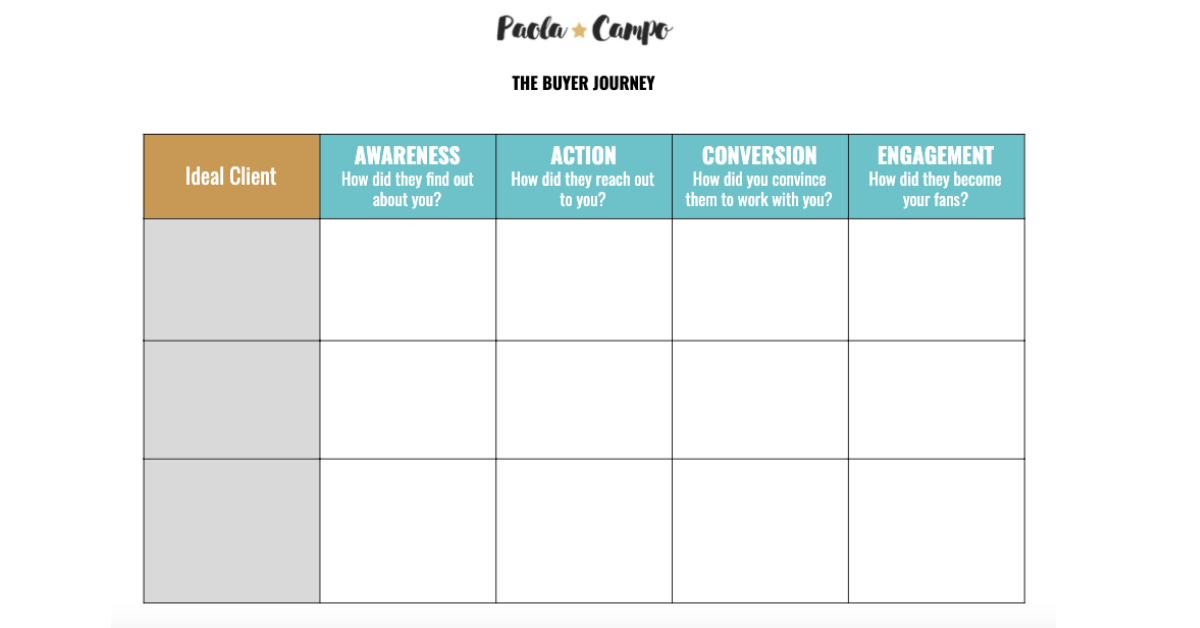Section 1: Your Content Strategy Basics
1.2 The Buyer Journey
Going from having a potential client interested in your product or service and eventually buying will require a few steps in between. Understanding your client’s buyer journey will be crucial

Your content strategy is like dating.
You meet someone, and you really like them. Would you want to marry them immediately after you meet them?
Some people would feel that way, sure. But let me put it this way. Would you expect to set a wedding date for one week later? Not likely.
Content marketing is all about building relationships, too.
Every piece of content your share with your potential clients can take you one step closer to building a strong partnership. And like dating, sometimes things can go faster, other times, you need a little more time.
Next to understanding your value proposition and your ideal client, understanding your client’s buyer journey will be crucial.
Why some clients will buy now, while others buy later
When you break down your business’ entire potential client audience, only 3% of those are ready to buy right now. About 7% of them might consider buying with enough arguments. 30% are not thinking about buying, and another 30% don’t believe they are interested in buying. And then the final 30% is definitely not interested.
This concept is that of “The buyer’s pyramid,” one of the fundamental principles in the late Chet Holmes’ book The Ultimate Sales Machine.
Your content strategy efforts are working in two ways.
First, you are staying relevant in your potential client’s mind so that when they become the top 3%, they’ll sign with you. Second, by consistently creating valuable content, you might just accelerate your potential client’s buying time frame.
Mapping your buyer’s journey
Going from having a potential client interested in your product or service and eventually buying will require a few steps in between.
Think about the process that goes into buying a car, for example.
You’re probably going to be doing some research first. You’ll search reviews, verify your finances, and then head over to the dealership to take a look. Maybe you test-drive, then perhaps buy.
Your buyer’s journey will consist of those incremental steps that lead your potential customer to buy what you sell (and beyond).
Grab the worksheet below to begin tackling those steps, in the context of your ideal clients.
Awareness
The awareness stage of your buyer’s journey answers the question, “how did they find out about you?” If you’re starting with content marketing, your potential client’s awareness stage will involve more direct contact, such as networking events, referrals, or cold calling. Think about all the information that flows during that stage and ask yourself: what made this person go, “interesting, tell me more.”Action
Once that potential client asks you for more information, you’ve piqued their interest, which means they’re in the journey’s action stage. This is a pretty important stage because it’s the moment when strangers become “prospects.” Think about all the questions they ask you about your product or service. What are your key messages? What are their objections? How do you counter those objections?Conversion
The conversion stage is the top of the mountain for many entrepreneurs. It’s the moment you get the reward for your hard work. It answers the question, “how did you convince them to work with you?” Think about what were the key selling points. Like the action stage, reflect on the kind of information, offer, or perk that helped you close the deal.Engagement
You could stop at conversion, but what if the people you work with become your ambassadors? That could open the door for even more business to come your way. Referrals continue to be one of the most powerful ways to get new clients. Think about the aspects of your product or service that made your clients loyal. How did they become your fans? Understanding your potential clients’ interactions and how they move along those different stages will be crucial to create an essential component of your strategy: Your marketing funnel.Section 1: Setting Up Your Content Strategy Basics
A successful content strategy will need a solid foundation to help your business grow.
In this section, you’ll learn how knowing your customers, and the value you deliver to them will shape your path to achievement.
Section 3: Implementing Your Content Strategy
Turning potential clients into closed deals needs content that moves them along every stage of their buyer journey.
In this section you’ll start to get their attention and establish yourself as a reliable partner.
Section 2: Planning And Building Your Content Strategy
Creating content that grabs the attention of your potential client begins with an idea.
In this section, you’ll be turning ideas into a concrete action plan that will set the wheels in motion to establish yourself as a reliable partner.
Free Courses
Duis egestas aliquet aliquet. Maecenas erat eros, fringilla et leo eget, viverra pretium nulla. Quisque sed augue tincidunt, posuere dui tempor.

